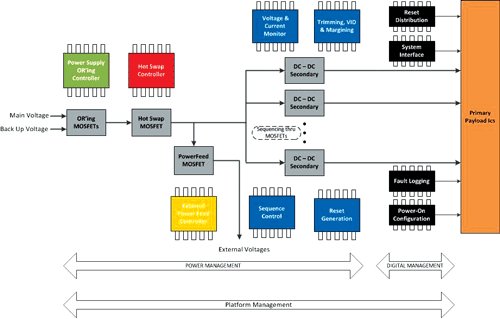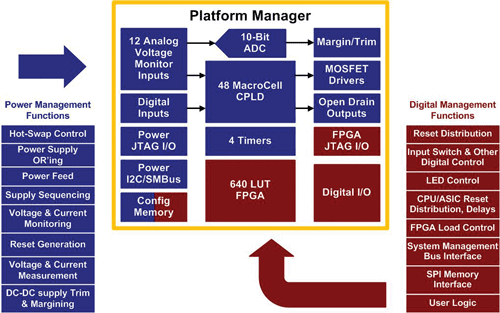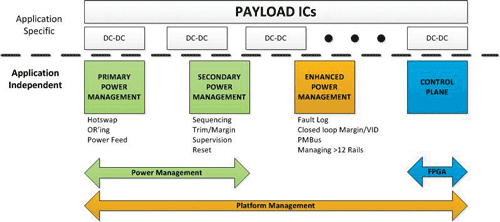Transforming circuit board design reduces cost and risk
An integrated, programmable platform management system supported by simulation software simplifies design and reduces the risk associated with building complex systems
BYJEFF HOOKER
Senior Product Marketing Engineer
Lattice Semiconductor
www.latticesemi.com
Aggressive cost targets, tight schedules and poor system planning often result in power supplies that are poorly managed, causing malfunctions and directly impacting the reliability of the system. What if there was an easy and systematic way to implement reliable power management while reducing cost and minimizing design resources? And what if this design was flexible enough to eliminate the risk of redesign and be standardized across multiple boards?
As the functions of primary payload ICs become more complex, so do their power requirements. Systems can require several different voltages to power the various digital and analog chips that are referred to as the primary or payload ICs. Complex chips can require multiple voltage rails to power their core, secondary and interface sections. With the requirement for more voltages with tighter tolerances also comes the need for better power management that addresses sequencing, monitoring and conditioning. Once the system power supply requirements are addressed, digital management functions are needed to enable the payload ICs. This combination of a system’s power and digital management is referred to as platform management (Fig. 1).

Fig. 1: Discrete platform management
Power management is typically implemented using multiple, small off-the-shelf single function ICs, whereas digital management is often implemented using combinations of CPLDs, FPGAs and discrete digital ICs coupled with timing resistors and capacitors. However, implementing platform management with discrete ICs creates several troublesome design issues. First, designing reliable platform management in this way requires the selection of high precision parts that add cost. Second, a design using discrete ICs will have a control system with a slow reaction time that is inadequate to react to faults or provide time for fault logging. Third, with a design using discrete ICs it is impossible to accurately simulate the system. And fourth, any design changes will necessitate a board redesign. Sound familiar?
Platform management functions
Let’s start by defining each of the typical functions included in platform management.
Sequencing control, voltage monitoring and reset generation
A system’s primary functions are supported by voltage regulators that require sequencing on and off. During sequencing, supplies should be monitored for faults and, if a fault occurs, the CPU should be issued a reset.
Power supply trimming, VID control and margining
In order to meet the dynamic power requirements of complex ASICS and CPUs, core supply voltages must be maintained within a tight range. Trimming allows power supplies to maintain tolerances narrower than specified in their data sheets. Power supplies can also be required to change voltages for different modes of operation. Microprocessors can use voltage IDs (VID) to dial in supply voltages, or ICs may request a change in voltage during a lower performance or sleep mode. Supplies can be margined for four corners testing for quality. Margining skews supplies to their maximum and minimum values in order to test the robustness of the design to power supply variations. Margining can be done for design verification, but can also be used in production or for troubleshooting an intermittent board operation.
Hot swap or power feed
Circuit boards that are inserted into a powered, or hot, socket require that the inrush current be controlled to keep the host power supply from drooping and resetting. Current control located on a daughter card is considered Hot Swap. Current control that feeds power to an external device is referred to as a Power Feed. Both functions have similar design considerations for controlling current and protecting the power switch.
Power ORing
System reliability often requires redundant power supplies. Diode ORing allows power delivery to be shared or maintained by the good or prevalent power supply. Replacing the ORing diodes with MOSFETs can greatly improve efficiency, but can allow the reverse current to flow into the lower voltage supply or ground. Monitoring and controlling current direction becomes essential to prevent damaging supplies.
Digital management and reporting
Once the system’s power supply requirements are addressed, digital management functions are needed to enable system sequencing and hardware configuration through reset distribution, system interfacing and power-on configuration. In case of system failure, fault logging — essentially the design version of an airplane’s black box — can be added to capture a snapshot of the event. The ability to quickly identify the event that caused the board to fail can significantly lower the cost of repairing faulty boards.
Drawbacks of implementing platform management with discrete ICs
Reliable platform management design should be approached from a system perspective. But systematically communicating with all of the discrete chips in a design is both difficult and costly. The level of expertise necessary to design reliable discrete platform management is often underestimated. The task usually is assigned either to the power supply designer, who does not fully comprehend system requirements, or the digital designer, who is unfamiliar with power supply design. A true system approach will join digital and power management together seamlessly.
Platform management using discrete ICs requires a different selection of components and separate verification testing for each board. A wide variety of discrete parts adds a significant amount of additional components to the bill of materials and reduces reliability. Discrete power management require various combinations of hot-swap controllers, reset generators, voltage supervisors, watchdog timers, CPLDs, resistors and capacitors. Researching data sheets can be daunting. For example, Linear Technology has over 70 different Hot Swap ICs, and On Semiconductor has at least 450 different reset and supervisor ICs. Digital management adds an FPGA or discrete TTL components. Choosing a solution using discrete components requires weighing the many tradeoffs between price and performance. Implementing these functions requires a unique combination of ICs for each design, and on a tight budget designers usually use less expensive, less accurate devices, resulting in reduced reliability. After the initial design has been committed to hardware, any design changes will require a board respin. How many times has a design been good enough — or had a blue wire added — to avoid a change?
Resolving discrete power management issues
Integrating power management into a single IC will significantly reduce cost by providing all the power management functions needed and eliminating duplicate functions, because functions that share common resources can be combined. The multiple voltage supervisors, sequencers, hot swap controllers, reset generator ICs and trim and margining functions can be integrated into a single IC. A single extremely accurate band-gap reference can be shared by multiple functions, further lowering cost without sacrificing accuracy or reliability. More importantly, integration can eliminate the communication time delays that occur when using multiple discrete ICs. Faults would be acted upon in tens of microseconds instead of the hundreds of milliseconds typical for a microprocessor-monitored system. Trim, margin and voltage measurements can easily be accomplished by adding an ADC and a DAC.
ASSPs can integrate some of the discrete devices required in power management, but still require additional ICs, including a microprocessor, to complete the solution and can have some superfluous functions not required for the application. The design is hard to simulate and, being “fixed,” it will require a respin of the board if any changes are needed.
Platform management
Integrated devices such as Lattice Semiconductor’s Platform Manager overcome the power management issues by incorporating Hot Swap and ORing controllers, sequencers, watchdog and voltage supervisors, voltage measurement, trim, and margining in a completely programmable device (Fig. 2 ). A CPLD-based architecture makes it extremely adaptable to design changes and is easily standardized across multiple systems. The CPLD control allows response times of less than 50us, overcoming the long delays of microprocessor-based systems.
The board’s digital management has typically been partitioned into a separate FPGA that manages the primary payload ICs. The FPGA portion of Platform Manager can be programmed to offload system initialization, reset, and hardware configuration. Removing these functions from the system FPGA frees it to perform the primary requirements of the board. More importantly, by integrating digital management with power management, full simulation of all secondary features of the board can greatly reduce design risk.

Fig. 2: Integrated platform management.
Enhanced Power Management Functions
The integration of power and digital management into a single programmable device enables the addition of enhanced functions that have previously been difficult to implement for most designs (Fig. 3 ). A single device, for example, can seamlessly monitor all secondary functions for faults, capturing the cause and not just the result of a partially monitored system. Capturing the preliminary fault and preserving it even as the system fails significantly aids troubleshooting and can mean the difference between a field repair and scrapping the board. Programmability allows platform management to perform control of power supplies, enabling features like dynamically changeable margining and flexible VID control. Additional features can be added to suit particular applications like a PMBus interpreter that allows less expensive power supplies to respond like highly accurate, digitally controlled supplies. Platform Manager puts these enhanced features within the reach of designers with various downloadable IP cores. It is easily tailored to even the most complex systems by adding Lattice’s Power Manager II devices. The parts can be linked through I2C communications to systematically monitor and control over 30 voltages and hundreds of IOs.

Fig. 3: Integrated platform management provides enhanced functions.
Careful attention to platform management increases the reliability of a design and contributes to a product’s success. An integrated, programmable platform management system supported by simulation software simplifies design and reduces the risk associated with building complex systems. Lattice’s Power Manager II and Platform Manager devices provide flexible management of a board’s secondary functions while allowing the addition of features that make it readily adaptable to a wide variety of applications. ■

Jeff Hooker is a Senior Product Marketing Engineer at Lattice Semiconductor Corporation. Prior to joining Lattice, Jeff was a design engineer for Texas Instruments and has been in technical marketing and business development for Comlinear, National Semiconductor, Micrel and Microsemi. He holds a BSEE from the University of Washington and MBA from the University of Dallas. Jeff welcomes your feedback and can be reached at
.
Advertisement
Learn more about Lattice Semiconductor





